Keeping up with the Clean Skins!
Host: Anthony Lagoon Station
Written by Georgia Clark – AACo Graduate Program 2016.
Coming from a small place property in NSW, branding is something I had never experienced and I definitely underestimated the scale and numbers they can work with on a cattle station.
Branding has been one of my favourite activities whilst living and learning here at Anthony’s. Knowing you are involved with a process that is so vitally important to the station and to the beef industry is very rewarding – and you are working with the whole stock camp team in the yards – everyone is working hard, pumped up to process as many weaners as possible, and the energy is high throughout the day, everyone feeds off each other! You may have guessed but I love working with people as much as I love working with cattle!
What is Branding?
While typically branding means marking the hide of the animal with a shape or series of shapes and letters that indicate it belongs on a particular property, “Branding” on a station includes a whole number of processes for weaner cattle that make the rest of their lives travel easily without concern, injury, or illness.
It is important that we “brand” every weaner, both mickeys (young uncastrated bulls) and heifers (young females). Aside from giving the managers an indication of how many calves were born on the station in one season, it allows the cattle to be tagged and branded for identification purposes. This is required by both the NT government and the Federal government.
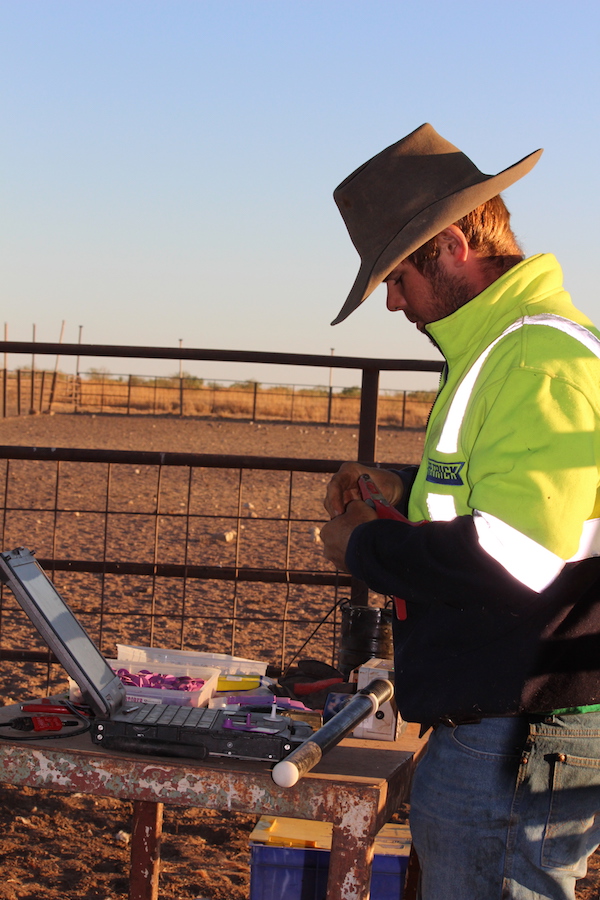 Mick Pocock working hard on our cattle ID system.
Mick Pocock working hard on our cattle ID system.
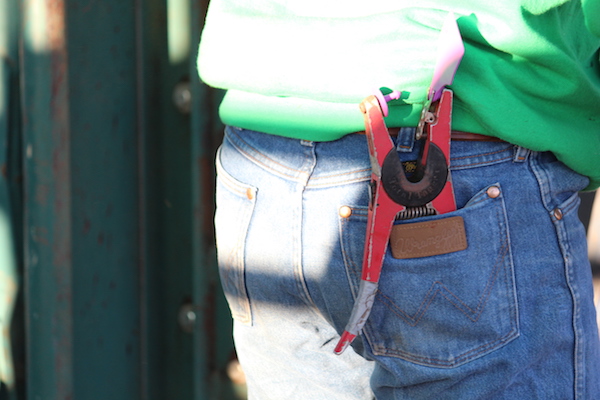 Toby from the stockcamp ready to tag the next weaner.
Toby from the stockcamp ready to tag the next weaner.
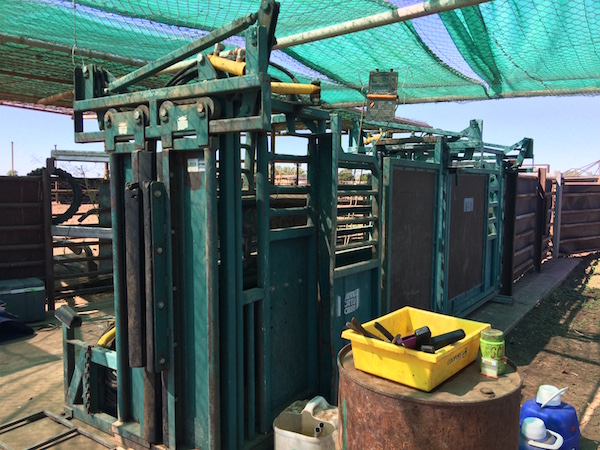 The hydraulic cradle set up and ready for a day of branding – sometimes you can brand over 500 head in one day!
The hydraulic cradle set up and ready for a day of branding – sometimes you can brand over 500 head in one day!
The Process:
What Do We Do?
Tagging: the NLIS tag (National Livestock Identification Tag) is an electronic tag that is inserted in the right ear of each weaner (just like a pierced ears) and is a legal requirement across Australian. NLIS tags hold a lifetime of information on the individual animal. This includes the breed, horn status, property on which it was born, vaccinations, any movements between paddocks, any movement between properties, weights and pregnancy statuses. At Anthony’s we also utilise Visual Identification Tags – a numbered tag inserted into the left ear that is colour coordinated to the year of birth for Anthony Lagoon. Each animal receives an individual number in the colour of the year it was born that is linked to the NLIS tag number. It is very important that the station keeps records of all cattle for planning and management along with notification for the NLIS system.
Castration: this is an important process to ensure that injuries and unwanted pregnancies do not occur. Mickeys are castrated to limit their bull like behaviour. Castrated male cattle area known as steers and can be held together in paddocks and yards with limited fighting or aggressive behaviours, making handling safer for both the cattle and for the humans! Castration of mickeys has also shown to improve meat quality characteristics – very important on a beef station!
Branding: is the marking of the animal hide for identification purposes. Cattle can be cheeky and don’t mind having a scratch on fence posts, trees, each other, anything they can find! This scratching along with the occasional faulty tag means that identification tags can sometimes fall out or go missing. Having branded cattle means that they can be identified as being bred on Anthony Lagoon station and can be returned if they manage to wander off through a broken fence! It is also a legal requirement for all cattle bred in the Northern Territory to be branded.
Ear Notching: another form of identification! It is very important that we can identify who they are and where they have come from. Anthony’s has its own ear notch identification that is applied to the left ear. There is also a notch that is applied to the right ear to that indicates if an animal has been treated with growth supporting tool.
Vaccination: good stockmanship also includes the health and wellbeing of the cattle, not just maintaining feed and water. Cattle can be infected by a number of pathogens and diseases that exist in the soil and air. Cattle at Anthony’s are vaccinated against botulism and clostridial diseases to keep them healthy and happy!
Dehorning: an animal with horns can cause injury to themselves, other cattle in the mob, and to humans and horses if they are working in confined spaces. Horns can also lead to animal becoming caught in yards when being drafted or trucked. To stop these injuries, weaners have their horns removed by trained stockmen and women with a safe and efficient technique that puts the least amount of stress on the animal. This can be a stressful time for the animal however it is so important for minimising their risk of injury later in their lifetime. Anthony Lagoon station is also managing their herd to decrease the horned cattle on the station by selectively breeding for polled cattle. A polled animal is one this is born without horns – a genetic trait that is helping to improve the entire herd on Anthony’s.
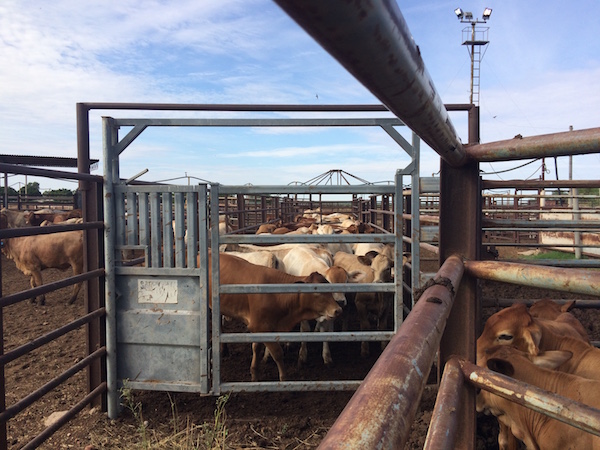 Some of Anthony Lagoon’s weaners ready for their turn up in the cradle!
Some of Anthony Lagoon’s weaners ready for their turn up in the cradle!
How Do We Do It?
To achieve all this we have a number of positions in the “branding team” that you can be stationed at. The stock camp members all work together to complete all those actions safely and accurate so the weaner spends a very short amount of time in the cradle (the holding system that restrains the animal while it is treated).
StockIt Chief: the person on the computer who records all the animal in the system. We record the NLIS tag number the visual tag number, the weight, breed, sex, horned status, any vaccinations or treatments and which paddock it will be moved to once it is completed.
Although this is the least favourite position of many – I really don’t mind it! You are moving as fast and efficiently as possible, making sure you are a step ahead of the crew, recording all the correct data and jumping out from behind the desk to help with the tagging as much as possible!
“On-The-Head”: the person on the head has a lot going on! They put the tags and notches in both ears, administers vaccinations and treatments and will dehorn if they deem necessary (i.e. not if they are polled). It is a very fast paced job and they dictate the pace of the whole branding process.
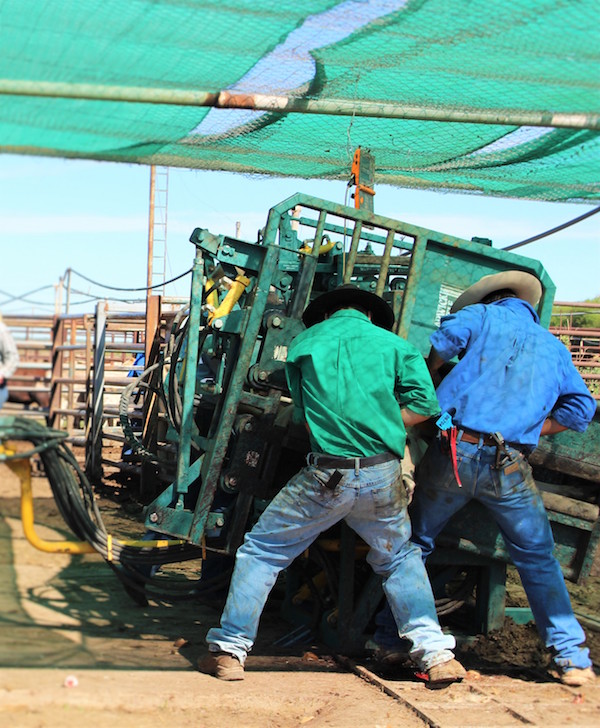 Connor and Toby working together on the head – classic Anthony’s teamwork!
Connor and Toby working together on the head – classic Anthony’s teamwork!
Castrator/Lever Operator: an Anthony Lagoon, we are lucky enough to have a hydraulic cradle and crush system, better for the bodies of the stockman and women – particularly when they are branding for days at a time! The castrator will operate the hydraulic system to let cattle through into the cradle and crush to be weighed and then the rest of the branding process. Once the beast is rolled onto is offside they will castrate the animal (mickeys only – heifers are only tagged, branded, treated and dehorned if necessary). The castrator will also brand the animal, for Anthony’s that is on the nearside (left side) rump.
Backleg/Backyards: these people are pretty important! They keep the cattle up to the team working on the cradle. They work the weaners through a number of yards, pens and then races to make sure there is cattle ready at all times. One person that is working the race will also help with castration by “back-legging” or holding the back leg of the mickeys out of the way of the castrator.
When we are branding heifers the person in the backyards and on the race often also gives any vaccinations as they are not needed for castration.
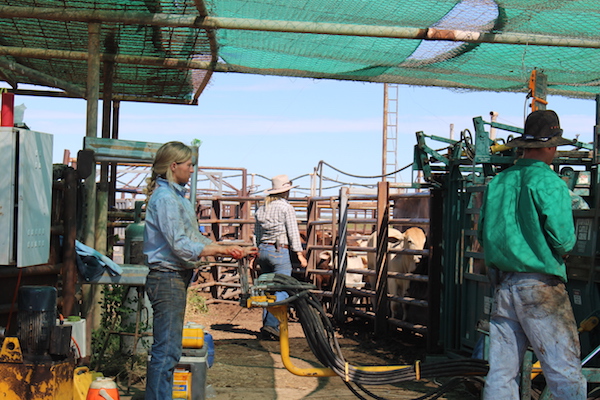 Team Work! Addy working the leavers and castrating, Michelle in the backyards, Billy vaccinating, and Connor ready on the head.
Team Work! Addy working the leavers and castrating, Michelle in the backyards, Billy vaccinating, and Connor ready on the head.
Branding is an important process on any station and I know that I looked forward to any days I could spend out with the camp! I have learnt so much from the team during these branding days and it has been so impressive to watch the new camp members pick up and improve these techniques and skills.
There is so much to learn about the branding procedure so if there is any questions out there please don’t hesitate to give us a bell and I will endeavour to find some answers for you!
Happy Branding!
– The Rookie Graduate
